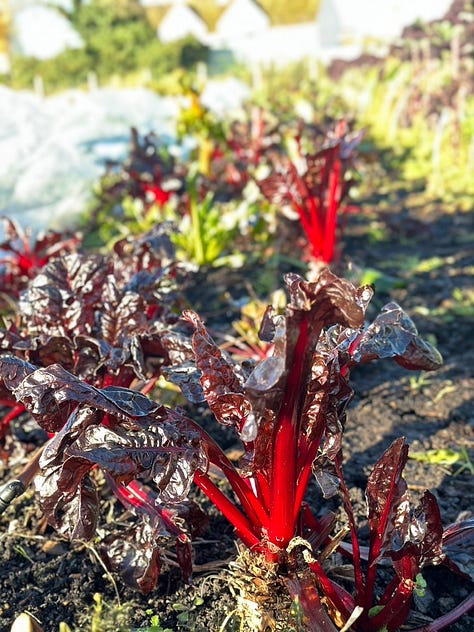In Good Taste #70: Christmas Puddings
The "best Christmas puddings ever" (not my words); some ferments for Christmas; Conclave and a new podcast
Well, hello there! How are you?
Good I hope.
(Not up for the chitchat? Completely get it. Click the email title to go to a web-based version then jump straight to the recipe or Cultural Fun.
I’m OK although I began the week feeling deflated and furious with myself. I was supposed to go to Seville at the weekend to see my good friend Ruby. I’d been looking forward to it for a long time but whilst packing on Friday morning realised my passport wasn’t within the three months you need to travel to Europe.
I went to the airport anyway to see if there was any wiggle room - just a few days out! And I was going for less than 48 hours! - but of course there wasn’t. So I returned home and spent the whole weekend thinking “I ought to be in Seville now…” It’s so out of character for me not to have triple checked any travel details and I couldn’t bear that I had let my friend down.
So. Anyway. The bitter/sick feeling has worn off but I am still sad. Hopefully the trip can be rescheduled for as soon as I can get a new passport.
But I was cheered by Wednesday’s Hornsey Vale Community Centre Christmas Lunch Club, an event I’ve been cooking for since (I think) 2019. This year’s was the biggest turnout yet. Turkey or nut roast and all the trimmings for 71 strained the centre’s oven capacity to its limits but with a lot of tray-juggling, an amazing volunteer team and the centre’s lovely staff it all went off smoothly.
It’s always worth the stress for how happy people seem afterwards and we were all very moved by the thanks we received. People are always especially complimentary about the Christmas puddings so I thought I would share the recipe. I’ve cobbled it together over the years but probably owe most to Felicity Cloake and Nigella. It is fruity and boozy, simultaneously light and rich. I am not good at tooting my own trumpet but I will report that multiple people among the HVCA crowd each year tell me it’s best they’ve ever had.
I know you’re supposed to make your pudding on stir up Sunday (I only found out this year that the stirring refers not just to puddings but to the collect for the day from the Book of Common Prayer: "Stir up, we beseech thee, O Lord, the wills of thy faithful people...") but I reckon that if you got these going this week they’d do you for Christmas. They keep well so your 2025 Christmas self will thank you too.
Ferments for Christmas
We’ll get to the pudding recipe in a minute but I just thought I’d point out that now is a good time to maybe get a few jars of ferments going. Things to give as gifts or eat alongside leftovers.
I did a bumper issue last year with recipes for beetroot “gold coins”, Christmas kraut, fermented cranberries and chilli sauce. Also suggestions for “sauersprout” or brine pickled versions. Have a look here:
Ruby Kraut or Piccalilli would be my top picks for accompanying leftovers. Usually the archive is for paid subscribers only but I have opened it up until the New Year so you can mine for inspiration.
Gift suggestions
And if you’re looking for gift suggestions for ferment-curious relatives and friends, how about a voucher for a private lesson or a ticket to my Oxfordshire Field-to-Ferment workshop in January?



I’ll have a few book recommendations and other bits and pieces to suggest next week too.
Recipe: Christmas Pudding
OK. Here we go. This makes about five pints-worth of pudding and I usually distribute that between a few basins of various sizes for gifts as well as family. A one-pint pudding can feed four generously, six more moderately or eight who want “ooh, go on then, just a touch…”.
I’ll be bringing a two-pinter home for my family (seven adults and three kids who will probably turn their noses up at it) plus a back-up pint pudding, just in case people are still hungry. Leftovers are delicious fried in butter for breakfast, folded into ice cream or repurposed into a rocky road-esque chocolatey hodge-podge.
But obviously scale the recipe down if you only want one pudding.
On a practical note, I get my pudding basins from Just Pudding Basins. Their lidded plastic bowls are not as pretty as a traditional ceramic one but they save you all the faff of buttering and folding baking parchment and trying to make everything watertight with only string. The name is a lie though. They sell loads of other things as well as pudding basins.
Ingredients
300g currants
300g sultanas
100g dried figs, chopped
100g candied peel
450ml Pedro Ximenez sherry
175g plain flour
2 teaspoons baking powder
1 teaspoon ground cinnamon
½ teaspoon ground cloves
½ teaspoon ground nutmeg
½ teaspoon salt
300g muscovado sugar
150g fresh brown breadcrumbs
300g suet
2 oranges, zest only
330ml stout or porter
100ml milk
3 eggs
3 tbsp treacle
100g slivered almonds
Method
Soak the fruit. Put the currants, sultanas, figs and peel in a bowl and pour over the PX sherry. Leave to soak overnight.
Grease the basins. Rub a little butter on the inside of your basins and lids.
Add wet to dry. Put the flour, baking powder, spice, salt, sugar, breadcrumbs, suet and orange zest in a large bowl. In another bowl or jug mix the beer, milk, eggs and treacle. Pour the liquid into the dry ingredients and mix to combine evenly.
Add the fruit and nuts. Stir in the fruit and its soaking liquid and the almonds.
Fill the basins. Transfer the mixture to your basins. It will expand during cooking so no more than three quarters full. Put the top on.
Steam the puddings. Add a steamer basket, upturned saucer or large piece of scrunched aluminium foil to the bottom of a pan big enough to contain the pudding basins in a single layer (it doesn’t really matter what, you just need something to stop the basins themselves sitting directly on the bottom of the pan - this is less important for plastic basins than for ceramic ones but still good to do). Make sure the basins are tightly sealed and place them in the pan. Pour boiling water to come about two-thirds up the sides of the puddings. Put a lid on the pan and steam for at least three hours for pint puddings and up to five for three pints. Check the water occasionally to make sure the pan doesn’t boil dry.
Let cool and set aside. Don’t open the puddings. Let them cool down then store somewhere safe.
Reheat and serve. You can either steam the puddings again to serve them or heat them through in the microwave. If steaming give them two hours in a similar set-up as they were cooked. But I find hob space is at a premium on Christmas Day so I tend to use the microwave. 5 minutes at full power, followed by a 5 minute rest and another five minute blast. Then gently warm some brandy, pour it over, set alight and bring to the table.
Notes (If Ifs And Ands Were Pots And Pans…)
Normal or vegetarian suet both work here. You can also substitute in gluten free flour and breadcrumbs with minimal effect on texture.
If you want a non-boozy pudding you can soak the fruit in strong tea instead of sherry and use Supermalt instead of the dark ale. But I wouldn’t advise keeping a booze-free pud for more than a couple of weeks.
We’re going to come back to our preserved oranges next week but, if you made some, you could use them here. Blitz a couple into a purée or finely chop and add instead of (or as well as) the orange zest. If you do, leave out the salt.
The longer you cook your pudding for - both in it’s initial steaming and whilst reheating to serve - the more its sugars will caramelise and the darker and more complex its flavours will get. I usually microwave rather than re-steam on Christmas Day so tend to give them longer in the first cook. A good five hours if I can. If you have hob space and a spare pan on the day you plan to serve, you can do three hours at first and another three hours on the day.
If you are adding any traditional family choking hazards (charms, sixpences etc.) obviously you can’t heat the pudding in the microwave!
If the puddings don’t all fit in a single layer in the pan you can balance some on top and switch over half way through. Be careful! Use tongs! Or else just cook them in a couple of batches.
Cultural Fun
On Monday we went to An Evening of Unnecessary Detail, a sort of scientific cabaret put on by “stand up mathematician” Matt Parker and his fellow Festival of the Spoken Nerd organisers. Favourite acts were marine biologist Elizabeth Mills on barnacles and Steve Mould on Curta calculators.
I went to see Conclave and really enjoyed it. Ralph Fiennes and Stanley Tucci are both great in this pope-selecting drama based on Robert Harris’s book. I imagine it will get several Oscar nods but, unlike many Oscar-nominated films of recent years, has an actual plot. Including quite a silly twist at the end.
I loved the atmosphere of it. All the cardinals gathering in the Sistine Chapel to pick a new pope are dressed in their ceremonial robes and there are beautiful shots of the Sistine Chapel (or a carefully recreated replica anyway) and other Vatican-y locations, all marble staircases and monumental pillars. It powerfully evokes the centuries-old might and compelling mystery of the Catholic church.
But the red-caped cardinals are also seen sitting in people carriers, puffing on vapes and using Nespresso machines. The bells-and-smells of it all contrasting jarringly with these modern banalities. So - it seemed to me anyway - under the politicking plot, liberal reformers vs bigoted traditionalists, was a invitation to think about the relevance of the institution itself.
I’ve been liking Alex Goldman’s new podcast Hyperfixed. The vibe is pretty similar to his previous show Reply All which folded in weird circumstances a few years back, and also to Search Engine, the show now presented by his former co-host PJ Vogt. Seemingly silly or simple questions leading to expansive and illuminating investigations.
I particularly liked the episode about measurements, a query about why American use cups for cooking instead of weights got surprisingly philosophical.
Bye! See you next week!
In the meantime, if you felt like sharing In Good Taste with friends or family who might enjoy it, you can do so with the button below.
Or upgrade to paid to support the work I do. Either would mean a lot to me. Thanks so much.
In Good Taste is a Sycamore Smyth newsletter by me, Clare Heal.
It’s free to subscribe and new issues will appear in your inbox every Thursday.
You can also access it via the Substack website or app where each issue remains free or a month after publication but older posts and archive access are for paid subscribers only. If you can afford it, do consider upgrading to paid to support my work - those vegetables won’t ferment themselves...
I also occasionally include affiliate links to Bookshop.org and will earn a small commission on anything purchased via a clickthrough.
You can also find me on Instagram or visit my website to find information about my catering work, cookery lessons and upcoming events.







